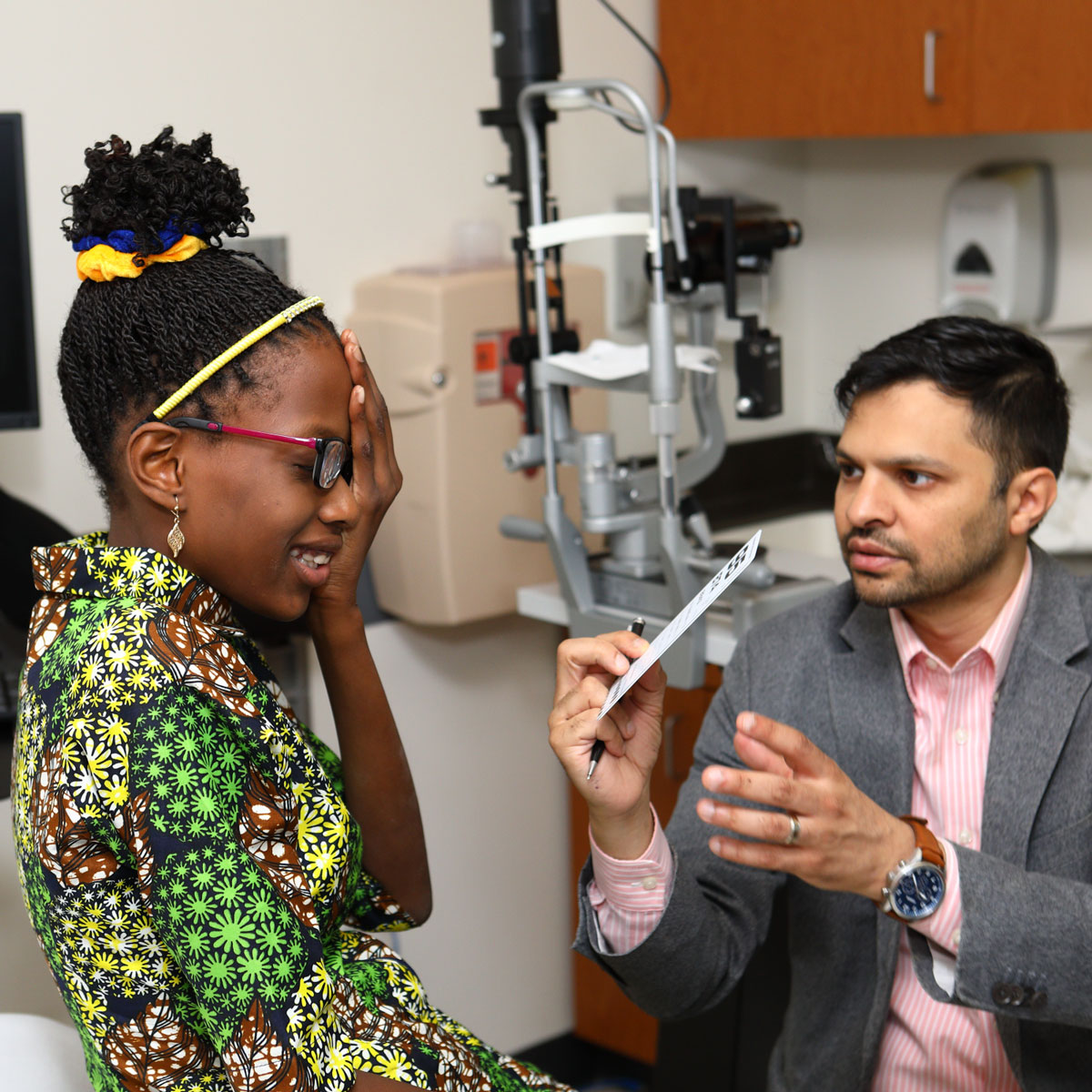What is Vascular Ehlers-Danlos Syndrome?
Vascular Ehlers-Danlos Syndrome, or VEDS, is a genetic condition that affects the body’s connective tissue. Connective tissue holds all the body’s cells, organs, and tissue together. It also plays an important role in helping the body grow and develop properly.
Connective tissue is made up of proteins. The protein that plays a role in VEDS is called collagen III. VEDS is caused by changes (or mutations) in the gene called COL3A1 that tells the body how to make collagen III. These mutations can result in faulty collagen III throughout the body or a reduction in the amount of normal collagen III in the body (depending on the mutation type). This creates the features and medical problems associated with VEDS.
Because collagen III is found throughout the body, VEDS can affect many different parts of the body, including the arteries, hollow organs, skin, and lungs. These systems can be prone to tear, which can be life-threatening.
Although VEDS is quite variable, people are often diagnosed when they have easy and frequent bruising that is not explained by other causes and spontaneous bowel and arterial tears or ruptures. Some people have characteristic facial features, thin skin, and tissue fragility.
The VEDS Movement is a division of The Marfan Foundation that specializes in education and support related to Vascular Ehlers-Danlos syndrome.
What are the Key Features of VEDS?
A family history of the condition, arterial rupture or dissection in individuals under 40 years of age, unexplained colon rupture, or spontaneous pneumothorax in the presence of other features consistent with VEDS should all lead to diagnostic studies to determine if the individual has VEDS. Genetic testing for VEDS should also be considered when there is a combination of the other minor clinical features.
If someone is diagnosed with VEDS, the genetic status of relatives should be clarified through clinical evaluation and molecular genetic testing.
When a person has these features, it is important to be evaluated for VEDS.
For more information, head to The VEDS Movement, a division of The Marfan Foundation.
-
Cardiovascular
- There is an increased risk of coronary artery dissection, and as a result, myocardial infarction (heart attack). In the event of myocardial infarct, there is an increased risk of ventricular rupture and pericardial tamponade (compression of the heart caused by fluid collecting in the sac surrounding the heart), resulting in sudden death.
- Non-myocardial infarct related mitral valve papillary muscle rupture has been seen
- Early onset of varicose veins
- Arterial rupture may be preceded by aneurysm, arteriovenous fistulae (abnormal communication between an artery and a vein) or dissection, or may occur spontaneously.
- Sites of arterial rupture are the thorax and abdomen, head and neck and extremities.
- The aorta, the main blood vessel that carries blood from the heart to the rest of the body, may enlarge or bulge (aortic dilation or aneurysm)
- Any artery in the body may enlarge or bulge (arterial aneurysm)
- The layers of any artery in the body (including the aorta) may separate or tear (aortic or arterial dissection). Typically, the medium- to large sized arteries are affected.
- Strokes are rare but can reflect involvement of cerebral or cervical vessels.
-
Eyes, Head and Neck
- Keratoconus (cornea of eye bulges outward causing thinning)
- Large or deep-set eyes (subtle protrusion is also a common feature and may result in failure to completely close the eyelids while sleeping)
- Carotid cavernous fistula may be recognized because of a sudden onset of a whooshing sound followed by pain around the eye which is caused by sudden engorgement of veins resulting from an improper communication between the arteries and veins behind the affected eye.
-
Skin
- May be thin, and the veins may be visible in some people.
- Prone to tearing and easy bruising.
-
Bones
- Some joints may be very flexible (double-jointed), typically the smaller joints.
- Joint pain may be present
- Congenital hip dislocation
- Congenital clubfoot
- Limb reduction defects (born with limbs which are shorter or longer than usual, or missing), which may be secondary to amniotic banding.
- Suspected increase in relative frequency of muscle and tendon rupture
-
Lungs (pulmonary)
- Sudden lung collapse, (pneumothorax) may be due to rupture of pulmonary blebs. This is usually an early manifestation.
- Spontaneous lung bleeding (pulmonary hemorrhage) resulting in hemoptysis (coughing up blood) is a rare complication.
-
Uterus
- The uterus may rupture, particularly during the third trimester of pregnancy.
-
Gastrointestinal
- The most common complication is spontaneous rupture of the colon, usually the sigmoid colon.
- Small bowel rupture is less common.
- Fistula formation following abdominal surgery is not uncommon.
- Esophageal and gastric rupture have been reported.
-
Oral
- Gum fragility with bleeding after brushing or flossing
- Gum recession
- Repetitive partial jaw dislocations and pain of the jaw.
-
Kidneys (renal)
- Renal artery dissection may lead to reduced blood flow, loss of renal parenchyma (functional parts of the kidney), and renal hypertension.

Getting Diagnosed with Vascular Ehlers-Danlos Syndrome
The diagnosis of Vascular Ehlers-Danlos syndrome, or VEDS, is based on careful assessment of the medical and family history and a physical examination that is designed to determine if major features are present. The diagnosis is then confirmed (or excluded) by the analysis of the DNA sequence of the COL3A1 gene (both copies), which can be extracted from blood, cells in saliva, or other tissues. This testing may include DNA sequence analysis, deletion/duplication analysis, and biochemical (protein-based) testing.
In many cases, people with VEDS are identified only after a severe complication or death. It is likely that individuals/families with mild outward features do not seek medical attention and thus go undetected. In addition, because of the perceived rarity of the disorder, it is seldom considered and non-vascular complications may not raise a doctor’s suspicion of VEDS.
Genetic testing detects 98% of the changes in the gene for VEDS; the rest require more specialized tests. Genetic testing is strongly recommended to confirm a diagnosis of Vascular Ehlers-Danlos syndrome when a person has any one of the major features of the condition. VEDS should be suspected in individuals with any one of the major features or several minor features, particularly in those younger than age 40 years.

What Causes Vascular Ehlers-Danlos Syndrome?
About half of people with Vascular Ehlers-Danlos syndrome inherited the COL3A1 mutation from an affected parent. The others have a spontaneous disease-causing mutation (called a de novo mutation) that occurred in either the egg or the sperm that gave rise to the pregnancy. As a result, they are the first person in their family to have Vascular Ehlers-Danlos syndrome without being inherited from a parent, and can now pass it on with a 50 percent chance of transmission with each pregnancy.
When the father or mother has VEDS, each offspring has a 50 percent chance of inheriting the altered copy of the gene. Male and female children are affected in equal proportion. During reproduction, each parent passes on only one of the two copies of each gene. If the altered copy of the gene is passed on, then the resulting child will resemble the parent who has VEDS and develop features of the condition. This pattern of inheritance is referred to as autosomal dominant.
Prenatal testing for pregnancies at increased risk and pre-implantation genetic diagnosis are possible in families in which the mutation in the gene is known.
How is Vascular Ehlers-Danlos Syndrome Managed?
The following medications are usually prescribed to reduce the risk for vascular stress and injury. However, there are no trials or long-term studies utilizing these drugs investigating protective effects or safety in this population.
- Beta-Blockers: Physicians usually suggest use of beta-blockers especially for those with high blood pressure but also when blood pressure is not high to try to minimize baseline vascular stress and influence on the integrity of the blood vessel wall. Typical beta-blockers that are prescribed for individuals with VEDS are atenolol, metoprolol, propranolol and others.
- Angiotensin Receptor Blockers: (ARBs) are another class of drugs known to control blood pressure but work differently from beta-blockers. As with beta-blockers, at this time, the benefit or risks of this class of drug remains unknown for individual with VEDS. Cozaar (losartan), Avapro (irbesartan) and Benicar (olmesartan) are typical ARBs.
- Celiprolol: is a third-generation beta-blocker only available in Europe. There are similar third generation beta-blockers, such as carvedilol, nebivolol, and labetalol, available in the US that are being prescribed off-label for this condition.
Imaging:
Currently, there are no evidenced-based guidelines for surveillance. Therefore, the type of surveillance and the recommended intervals for imaging for people with Vascular Ehlers-Danlos Syndrome (VEDS) vary from no imaging to imaging every 18 months.
When imaging is conducted and abnormalities are identified, monitoring is important to determine if treatment is appropriate. Doctors may recommend an annual physical examination. People with known artery problems may need an evaluation by ultrasound or computerized tomography angiography (CTA) or magnetic resonance angiography (MRA) at specified intervals.
Physical Activity:
- Pursue physical therapy, when appropriate. Some people with VEDS benefit from strengthening their muscles. A physical or occupational therapist can provide exercises to strengthen muscles without causing injury.
- Avoid circumstances that can cause medical problems. People with VEDS should avoid contact sports, heavy lifting or muscle straining, and activities that may include sudden impact or jarring of the body.
Maintaining Health Bowel Movements:
Because of the risk of bowel perforations with Vascular Ehlers-Danlos Syndrome (VEDS), maintaining healthy bowel habits and avoiding constipation is important.Some tips for maintaining a healthy bowel include:
- Eat between 20-35 grams of fiber a day. Fiber can be found in beans, fresh fruits, vegetables, and whole grains.
- Eat fewer low-fiber foods such as ice cream, cheese, meat, processed foods, and sugary foods such as soda and candy — which can cause constipation.
- Drink water frequently. Fiber and water are needed to maintain healthy movement through the bowel. Other fluids such as fruit juices are helpful. Avoid drinking excessive amounts of fluids that cause increase urination such as those that contain high levels of caffeine.
Many individuals with VEDS benefit from stool softeners and a regular laxative regimen. It is generally suggested to use bulk laxatives that draw fluid into the bowel, but to avoid stimulant laxatives that stimulate the bowel to contract.
Important Resources Related to VEDS
Emergency Preparedness
Following your doctor’s recommendations for medication, monitoring, and physical activity gives you the best chance of avoiding a serious complication with VEDS. Still, there are no guarantees. That’s why it’s important for you to learn about the medical problems that could arise and require immediate medical treatment.
The VEDS Movement has prepared a Vascular Ehlers-Danlos Syndrome Emergency Preparedness Kit to help you develop your emergency plan. It contains a VEDS Emergency Card, a letter to the emergency department, a fact sheet for EMTs and paramedics, and a checklist to help you prepare other documents you may need to have on hand during an emergency.





